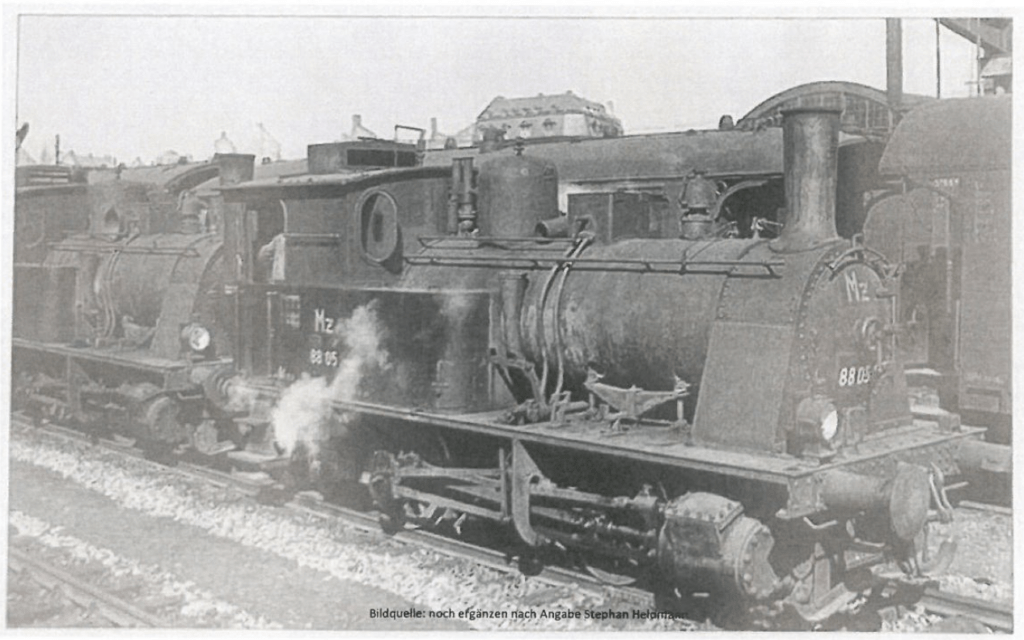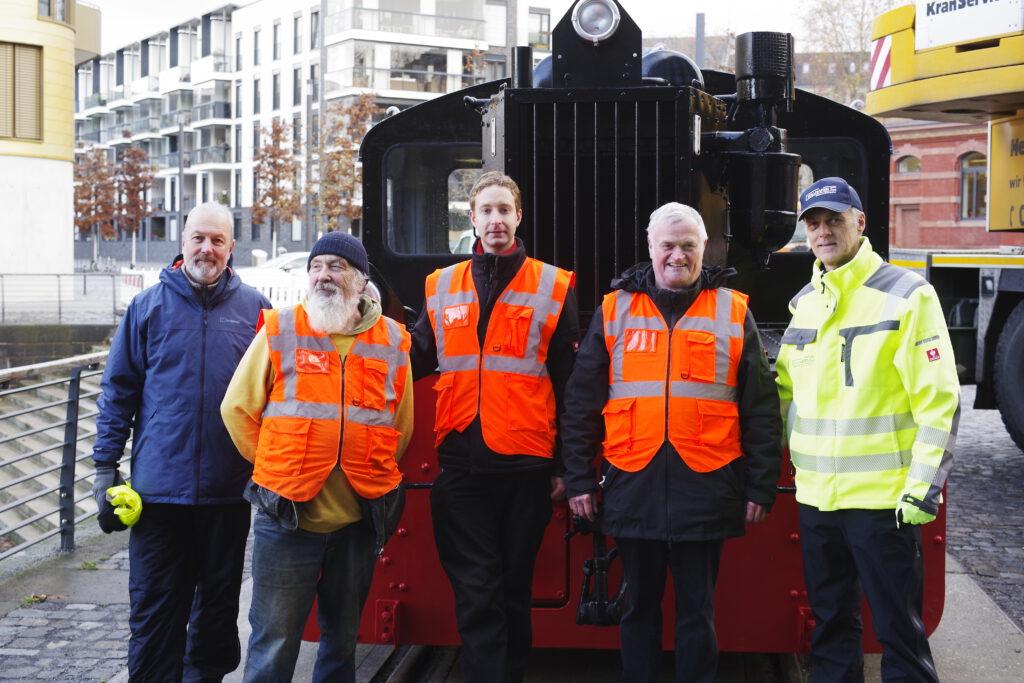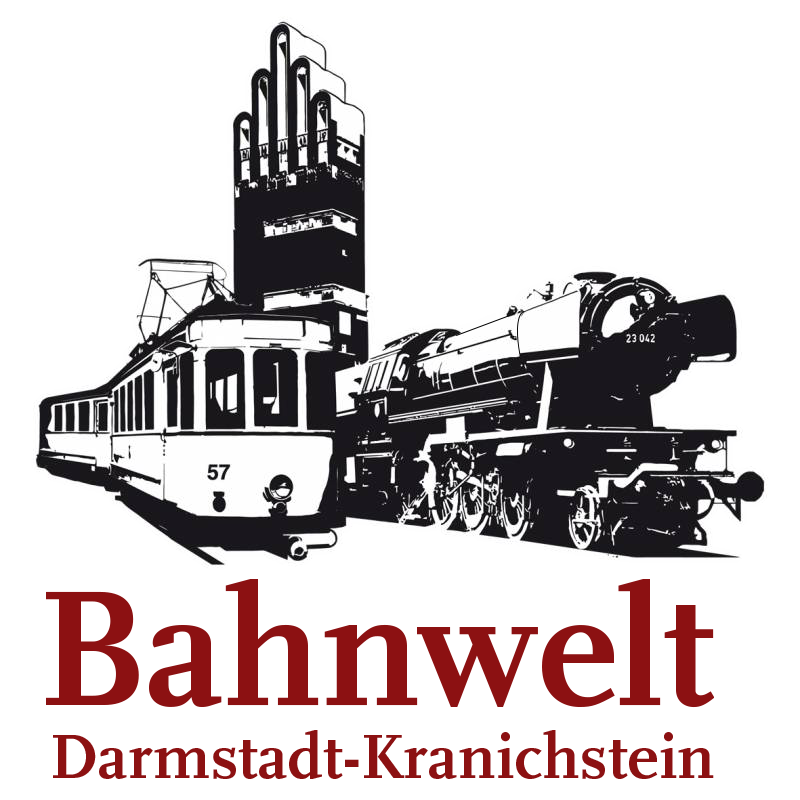Reconditioning a locomotive for the Mainz customs harbour
Reconditioning a locomotive for the Mainz customs harbour

In the summer of 2022, the Railway Museum received an unusual enquiry: we were put in touch with Zollhafen Mainz GmbH via the architect Daube, who is providing us with significant support in the reconstruction of the locomotive shed, and were told that they needed help with a “railway-related problem”.
As a project company of Stadtwerke Mainz and CA Immo Deutschland GmbH, Zollhafen Mainz GmbH has been entrusted with the task of developing the former customs harbour site in Mainz, located directly on the Rhine, into a modern quarter with numerous residential and business premises, partly incorporating historical buildings.
Initially, we were not entirely aware of the railway-related problems involved in the conversion of a harbour site, but they aroused our interest, which is why a meeting was arranged at short notice.
Research in the meantime has revealed that the “Mainz Customs and Inland Harbour”, located downstream on the Rhine in the direction of Mombach, began operations in 1887 and was primarily used for the handling of general cargo and bulk goods and their further distribution. As was customary at the time, the customs harbour also had extensive rail facilities to ensure the distribution and onward transport of goods. Operations were initially managed by the city of Mainz itself, from 1940 by the Deutsche Reichsbahn and after the Second World War by the newly founded Deutsche Bundesbahn. In the course of this, the three steam locomotives were also taken over from the harbour railway, assigned to the Mainz depot and re-designated. They continued to operate exclusively on the harbour railway and the vehicle number was preceded by “Mz”.

After the city of Mainz made the fundamental decision in 2003 to develop a new urban quarter on the site of the customs and inland harbour, the relocation of the local businesses began step by step. The old railway tracks were also gradually decommissioned. Instead, the new container terminal on the Ingelheimer Aue was connected to the rail network with a modern railway siding. In 2013, port operations in the customs and inland port were finally closed down completely. However, as a reminder of the times when shipping and railway traffic still took place in the customs port, a Kö II locomotive was erected on a memorial plinth at the Kunsthalle in 2008. Located directly on Rheinallee and initially illuminated at night, it is likely to be remembered by many pedestrians and motorists.


After extensive preparatory work by Mainzer Stadtwerke as the owner of the harbour, Mainzer Zollhafen GmbH was founded in 2010 to develop the harbour area, completely redesign it and ultimately hand it over to the city of Mainz. These measures follow a general trend towards the conversion of old industrial areas into urgently needed residential, cultural, industrial and commercial areas, especially in conurbations (see Frankfurt’s Westhafen). The start of construction work meant that the locomotive on the monument base had to be moved to a less prominent location, directly at the end of the southern harbour basin on a remaining track stub. Once the shell and building construction work had been completed, the outdoor facilities were designed. Here it is typical and very welcome from the point of view of monument preservation, industrial culture and history that elements that symbolise the original use of the facilities are also included in the design. One example of this is the design of the banks of the River Main in Frankfurt (Industrial Monument of the Year 2013), in which Bahnwelt contributed by providing two historic railway carriages. In Mainz’s customs harbour, old cranes were preserved and the locomotive was also given a new lease of life.
In the meantime, however, the vehicle had been robbed of its “face” through vandalism: Thieves had removed the original DR unit lanterns. This was the initial focus of the request for help from Mainz. However, these lanterns are no longer produced, are (apparently) also popular as devotional objects, are required by numerous museum railways and are also in short supply in the railway museum. Various suppliers were approached, including for replicas. However, the conclusion was quickly reached that the cost of re-installing exactly matching, historically correct lanterns would have been disproportionate to the benefit. This was particularly the case because theft or at least damage through vandalism could have been expected.
Advised by the museum in this regard, Zollhafen Mainz GmbH withdrew its enquiry for the time being, only to extend it considerably. They had decided to have the entire locomotive refurbished. In view of the overall condition of the locomotive, which had suffered considerably from the effects of the weather over the past 15 years, six new lamps would not have been enough.
This was followed by an on-site visit in late summer 2022 and a comprehensive assessment of the condition of the locomotive. The target condition, the required materials and substances, processes and labour costs were compiled and resulted in an offer from Musemsbahn e. V. to Zollhafen Mainz GmbH, which was agreed by mutual consent. With the commissioning and signing of the work contract in January 2023, the Museumsbahn e. V. became the supplier of an important urban development project in Mainz. However, this was not our most important goal. Rather, we are always pleased when historical railway vehicles are presented in an attractive public place and arouse the interest of one or two passers-by in railway history and technology. Of course, it’s even nicer when this is accompanied by a reference to the railway museum in Darmstadt-Kranichstein. It is said that Palatines have travelled across the Rhine to Hesse on several occasions …
It was also clear and agreed from the outset that the work would be carried out on a voluntary basis. This does not mean any compromises in terms of proper and professional workmanship, but it does mean concessions in terms of the speed of work. In return, 100% of the remuneration for the work performed, which we as a non-profit organisation have to charge at normal market rates, will go towards financing the work of the association and thus the railway museum.
For their part, those responsible at Zollhafen GmbH were delighted to be able to support a charitable institution and the museum by awarding the contract and appreciated the comprehensive advice provided in advance.
On this basis, a real win-win situation was created and the work could begin.
Transport of the locomotive
Working on the locomotive on site under an enclosure was rejected for various reasons. In the museum’s workshops, the working conditions are more pleasant, and tools, electricity, water, compressed air and the necessary spare parts and materials are available in sometimes terrifying quantities.
Supported by the company Hellmich Kranservice, Riedstadt, and the heavy haulage company Citlak, Mannheim, the locomotive was loaded in Mainz on 10 February 2023 in a four-hour operation, transferred to Darmstadt and placed on the track. The locomotive’s width of 3.07 metres made it necessary to obtain a special transport permit. In contrast to its visual condition, the technical condition was still very good, so that the locomotive could be made rollable without any further effort (“Ane Achs laaft a bissche schwer, aber das gebt sich…” (Hessian dialect for: „One axle is running a bit with difficulty, but this will come to pass“) and towed to the workshop by our chief engine driver Werner.

Inventory and preliminary work
The long period of cold and damp weather meant that further work on the vehicle was not possible. Instead, a precise work plan was drawn up, cleaning work was carried out on the interior and exterior, add-on parts were worked on (e.g. preparing the lights) and the work area was set up. In view of the new installation site directly on the water, it was also necessary to ensure that all operating fluids and lubricants were completely removed.
Dismantling work
For easier and more thorough processing, all add-on parts were dismantled (bonnets, battery boxes, etc.). Small parts that are not essential for the overall appearance and function as a monument, but which invite vandalism (windscreen wipers, brass parts, etc.) were permanently removed and the remaining openings sealed. The illumination formerly installed for the monument base was no longer desired and had to be completely removed.
Basic cleaning and removal of old paint and rust
The steam jet had already removed all kinds of moss, vegetation and old paint that was not firmly adhering. The areas affected by corrosion were mechanically derusted and then immediately treated with rust protection paint. To prevent future corrosion attacks as far as possible, generously dimensioned drainage holes were also drilled in some areas to prevent water from collecting and to ensure that dirt and dust that bind moisture are washed away by the rain. This is particularly important as the locomotive is not positioned exactly horizontally at its intended location.
Reconditioning in the interior
It is almost common to see large areas of flaking paint in the vehicle interior. This is due to the fact that the cabs were not insulated in the past, so that the outer wall is also the inner wall and is made of sheet steel. Due to the black exterior coating, the wall heats up extremely quickly in the sun and cools down just as quickly in the dark. The associated expansion and shrinkage causes the paintwork to crack, especially with the less elastic paints used in the past. This paint had to be completely removed. It was then primed with several coats of rust protection paint. The top coat was applied with two layers of impact-resistant, highly elastic and particularly temperature-resistant machine paint.
At the end of the work, the soiled wooden floor was sanded, found to be structurally sound, slightly reworked in the door areas and preserved by oiling.
Work rests due to Bahnwelttage
The traditional Railway World Days take place on Ascension weekend. The preparations and follow-up work as well as the three-day festivities completely tie up the museum’s volunteer staff, meaning that all other work is – just as traditionally – put on hold during this month.
Work on the roof
There were numerous small holes in the roof, probably originally from the former roof superstructures, all of which have now been sealed to prevent water from entering the interior. The surface of the roof was sanded down and primed with several coats of rust protection paint. The top coat was applied in RAL 9006 white aluminium. This differs from the condition of the last general inspection with a black roof (see also under “About the locomotive”), but ensures that the driver’s cab heats up less and results in an interesting visual contrast and a more pleasing appearance, which is also important for a monument. The Kö and Köf II of the DR had black roofs, while the DB vehicles always had silver-coloured roofs.
Painting the chassis
The chassis is largely protected from the weather thanks to its concealed position and only required extensive cleaning and repainting in RAL 3000 fire red in a single-coat process.
A delegation from Mainz visits the railway museum
On Sunday, 6 August 2023, Stephan Heldmann (spokesman of the association and deputy project manager) and Markus Hillmann (secretary of the association and project manager) welcomed a delegation from Zollhafen Mainz GmbH to the museum, who were able to see the work on the locomotive in the best rainy weather, but of course also received an extensive tour of the museum. Among others, our permanent contacts Mr Geiß and Mr Motzko-Lisy were present, with whom we were able to experience a very constructive and pleasant collaboration on this project in every respect.
A short time later, our architect Daube, who had organised the “deal”, came to see the progress of the work.
Top coating
Before the top coat was applied, all joints were sealed with body sealant to prevent water ingress and crevice corrosion. The entire construction of the locomotive with its many angled joints and horizontal surfaces cannot be described as particularly corrosion-resistant. The joint sealant also had to be reworked with primer.
Acid attacks and penetrating corrosion were evident in the area of the battery boxes. The only thing that helped here was renewed rust removal, rinsing and priming with rust protection paint.
Once all the preparatory work had been completed, all the exterior surfaces of the vehicle were thoroughly sanded. The entire vehicle could then be cleaned again.
The windows were masked, the top coat applied in several layers and sealed with clear varnish. The colour is RAL 9005 deep black, with the exception of the buffer beams, which are in RAL 3000 fire red, as is the running gear.
New window sills
The wooden window sills had been coated with top coat during the previous refurbishment of the locomotive. Water had penetrated the wood due to cracks in the paint and the wood had become rotten. Replacement was necessary, for which both window sills were dismantled and cut back to the sound material. An oak patch was then applied and protected against moisture with oil. The production of the profiles in our joinery was nothing more than a finger exercise for carpenter Stephan and was completed within a few hours.
New step gratings/circulation plates
The step gratings on the sides of the locomotive already deviate from the original wooden superstructure. Like all DR Kö and Köf II locomotives, expanded metal grilles were installed. These can hardly be reasonably protected against corrosion by painting. In addition, the filigree construction in the edge areas would sooner or later lead to them becoming clogged with dirt, collecting moisture and favouring rusting. So only one of the most efficient corrosion protection measures came into question: hot-dip galvanising, carried out by the company Hofmann-Rieg Stahlhandel in Darmstadt, which has already supported us very generously with various projects. The sandblasting work required for preparation was carried out for us in a tried-and-tested manner by the company S+M Sandstrahltechnik from Hofheim.
Final assembly and final cleaning
The windows were cleaned after the masking was removed – probably for the first time since 2005. Our Bernd and even our first chairman personally lent a hand and became so enthusiastic that you have to look very closely to realise that glass slides have been installed at all.
The original stumbling block for the project, the lanterns, were installed. They have now become standard SKL lanterns, which are still manufactured in this form today and are used on countless railway service vehicles. Of course, they are not historically correct, but are only subject to a very low risk of theft and give the locomotive a “face” again. The glass panes were of course replaced with shatterproof plastic panes.
The work was completed by applying the lettering to the side walls of the driver’s cab and the buffer warning paintwork. These are also not historically correct, but they are historicised and based on the aforementioned labelling scheme of the harbour railway in Mainz. This shows who has a steady hand for drawing the contours even at 8°C in the early morning.
Mounting of the locomotive
On 22 November 2023, the locomotive was ready for delivery and the doors were locked before the return transport to Mainz could begin on the morning of 24 November 2023. It was due to the usual “delays in operations” on the railway that the heavy transport did not set off until 11:00 a.m. instead of 9:00 a.m. as planned and therefore reached Mainz a good two hours late.
The representatives of Zollhafen Mainz GmbH, Mainzer Stadtwerke and the press, who waited out the rain and cold, nevertheless took favourable note of the arrival of the locomotive, both because they were pleased with the result of the work and because they were looking forward to being able to return to heated premises.
After setting up the crane and lifting the load, the locomotive was back in its place at 12:50 p.m., where it had left it on 10 February 2023 – just nine months earlier.
Previously, the installation area had been fitted with two track closures so that there is no danger of the locomotive rolling away for the time being.
We would like to thank all members, supporters, donors, sponsors and our client, Zollhafen Mainz GmbH, involved in the project for their trusting and committed cooperation and will honour this once again at the official inauguration of the locomotive when the outdoor facilities have been completed and the fencing has been installed.

About the locomotive
The locomotive corresponds to the type Kö II, i.e. a small locomotive with an oil (diesel) engine of performance group 2. It was manufactured by Orenstein & Koppel in 1933 with the factory number 20295 and entered service with the Deutsche Reichsbahn as Kö 4201 on 13 March 1934. After the Second World War, it remained in the GDR and was operated as 100 201-3, after reunification at DB AG as 310 201-9. It was decommissioned on 20 December 1995 in Meiningen, from where it was loaned on permanent loan to the Historische Bahnbetriebswerk Arnstadt e. V. . After being returned in 2006, the visual refurbishment was carried out again at BW Erfurt. Railion Deutschland AG donated the locomotive to Mainzer Stadtwerke AG at the beginning of 2008 and from summer 2008 it could be viewed as a memorial at its last location for the time being directly on Rheinallee.
The locomotive therefore spent the majority of its service with the Reichsbahn (DR) of the GDR and therefore also corresponds in its visual appearance to the specifications valid there for the main inspections and overhauls. Any deviations from this in the course of our refurbishment measures are indicated and justified in the text.

